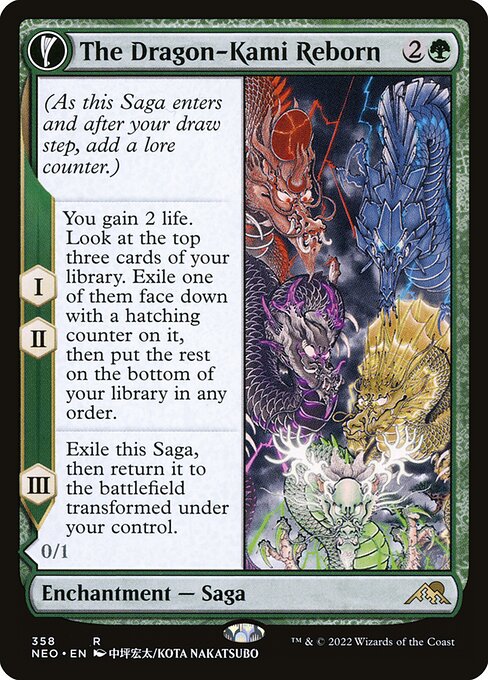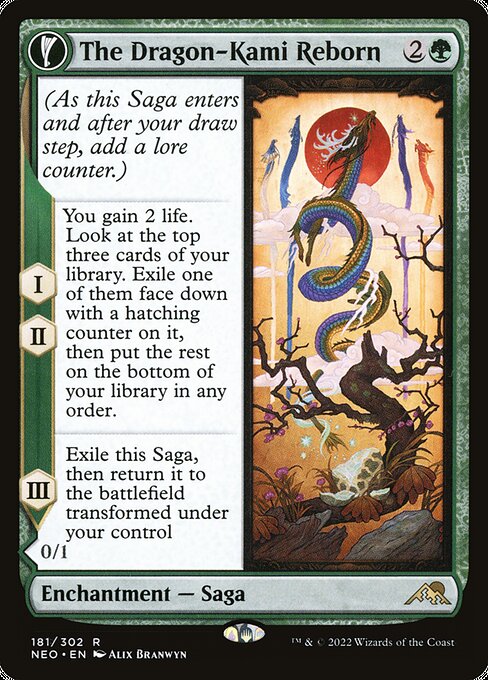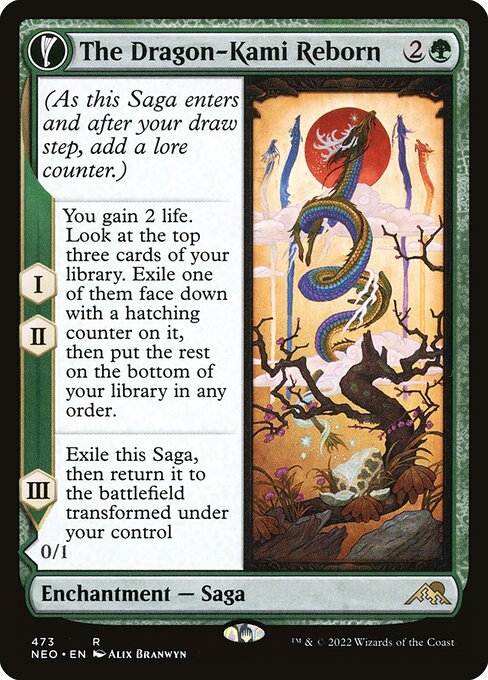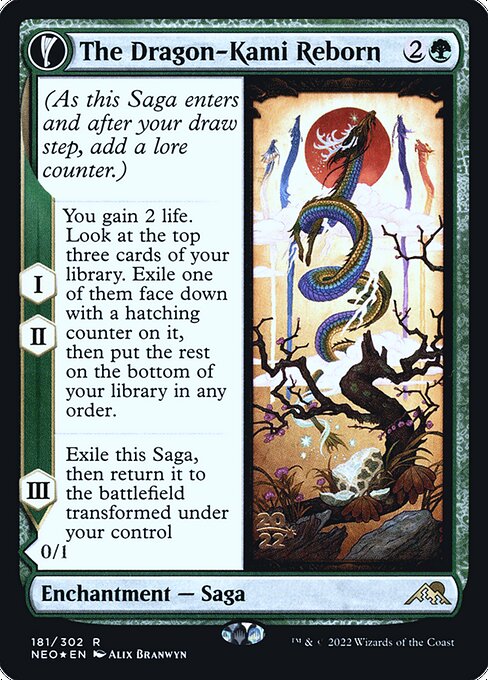The Dragon-Kami Reborn // Dragon-Kami's Egg
//
Enchantment — Saga // Enchantment Creature — Egg
(As this Saga enters and after your draw step, add a lore counter.)
I, II — You gain 2 life. Look at the top three cards of your library. Exile one of them face down with a hatching counter on it, then put the rest on the bottom of your library in any order.
III — Exile this Saga, then return it to the battlefield transformed under your control. // Whenever Dragon-Kami's Egg or a Dragon you control dies, you may cast a creature spell from among cards you own in exile with hatching counters on them without paying its mana cost.
I, II — You gain 2 life. Look at the top three cards of your library. Exile one of them face down with a hatching counter on it, then put the rest on the bottom of your library in any order.
III — Exile this Saga, then return it to the battlefield transformed under your control. // Whenever Dragon-Kami's Egg or a Dragon you control dies, you may cast a creature spell from among cards you own in exile with hatching counters on them without paying its mana cost.
0/1
standard
future
historic
gladiator
pioneer
explorer
modern
legacy
pauper
vintage
penny
commander
brawl
alchemy
paupercommander
duel
oldschool
premodern
Rulings
If Dragon-Kami's Egg and one or more Dragons you control die at the same time, the ability of Dragon-Kami's Egg will trigger once for each of them. Each time one of those abilities resolves, you'll be able to cast a creature spell from among cards you own in exile with hatchling counters on them.
Each face of a transforming double-faced card has its own set of characteristics: name, types, subtypes, abilities, and so on. While a transforming double-faced permanent is on the battlefield, consider only the characteristics of the face that's currently up. The other set of characteristics is ignored.
A transforming double-faced card enters the battlefield with its front face up by default, unless a spell or ability instructs you to put it onto the battlefield transformed or you cast it transformed, in which case it enters with its back face up.
If you are instructed to put a card that isn't a double-faced card onto the battlefield transformed, it will not enter the battlefield at all. In that case, it stays in the zone it was previously in. For example, if a single-faced card is a copy of Azusa's Many Journeys, the chapter III ability will cause it to be exiled and then remain in exile.
Each transforming double-faced card in this set is cast face up. In every zone other than the battlefield, consider only the characteristics of its front face. If it is on the battlefield, consider only the characteristics of the face that's up; the other face's characteristics are ignored.
The mana value of a transforming double-faced card is the mana value of its front face, no matter which face is up.
You may look at the cards you exile with The Dragon-Kami Reborn's first two chapter abilities, and you may continue to do so after it has left the battlefield.
The back face of a transforming double-faced card usually has a color indicator that defines its color.
Each face of a transforming double-faced card has its own set of characteristics: name, types, subtypes, abilities, and so on. While a transforming double-faced permanent is on the battlefield, consider only the characteristics of the face that's currently up. The other set of characteristics is ignored.
A transforming double-faced card enters the battlefield with its front face up by default, unless a spell or ability instructs you to put it onto the battlefield transformed or you cast it transformed, in which case it enters with its back face up.
If you are instructed to put a card that isn't a double-faced card onto the battlefield transformed, it will not enter the battlefield at all. In that case, it stays in the zone it was previously in. For example, if a single-faced card is a copy of Azusa's Many Journeys, the chapter III ability will cause it to be exiled and then remain in exile.
Each transforming double-faced card in this set is cast face up. In every zone other than the battlefield, consider only the characteristics of its front face. If it is on the battlefield, consider only the characteristics of the face that's up; the other face's characteristics are ignored.
The mana value of a transforming double-faced card is the mana value of its front face, no matter which face is up.
You may look at the cards you exile with The Dragon-Kami Reborn's first two chapter abilities, and you may continue to do so after it has left the battlefield.
The back face of a transforming double-faced card usually has a color indicator that defines its color.
Rulings
If Dragon-Kami's Egg and one or more Dragons you control die at the same time, the ability of Dragon-Kami's Egg will trigger once for each of them. Each time one of those abilities resolves, you'll be able to cast a creature spell from among cards you own in exile with hatchling counters on them.
Each face of a transforming double-faced card has its own set of characteristics: name, types, subtypes, abilities, and so on. While a transforming double-faced permanent is on the battlefield, consider only the characteristics of the face that's currently up. The other set of characteristics is ignored.
A transforming double-faced card enters the battlefield with its front face up by default, unless a spell or ability instructs you to put it onto the battlefield transformed or you cast it transformed, in which case it enters with its back face up.
If you are instructed to put a card that isn't a double-faced card onto the battlefield transformed, it will not enter the battlefield at all. In that case, it stays in the zone it was previously in. For example, if a single-faced card is a copy of Azusa's Many Journeys, the chapter III ability will cause it to be exiled and then remain in exile.
Each transforming double-faced card in this set is cast face up. In every zone other than the battlefield, consider only the characteristics of its front face. If it is on the battlefield, consider only the characteristics of the face that's up; the other face's characteristics are ignored.
The mana value of a transforming double-faced card is the mana value of its front face, no matter which face is up.
You may look at the cards you exile with The Dragon-Kami Reborn's first two chapter abilities, and you may continue to do so after it has left the battlefield.
The back face of a transforming double-faced card usually has a color indicator that defines its color.
Each face of a transforming double-faced card has its own set of characteristics: name, types, subtypes, abilities, and so on. While a transforming double-faced permanent is on the battlefield, consider only the characteristics of the face that's currently up. The other set of characteristics is ignored.
A transforming double-faced card enters the battlefield with its front face up by default, unless a spell or ability instructs you to put it onto the battlefield transformed or you cast it transformed, in which case it enters with its back face up.
If you are instructed to put a card that isn't a double-faced card onto the battlefield transformed, it will not enter the battlefield at all. In that case, it stays in the zone it was previously in. For example, if a single-faced card is a copy of Azusa's Many Journeys, the chapter III ability will cause it to be exiled and then remain in exile.
Each transforming double-faced card in this set is cast face up. In every zone other than the battlefield, consider only the characteristics of its front face. If it is on the battlefield, consider only the characteristics of the face that's up; the other face's characteristics are ignored.
The mana value of a transforming double-faced card is the mana value of its front face, no matter which face is up.
You may look at the cards you exile with The Dragon-Kami Reborn's first two chapter abilities, and you may continue to do so after it has left the battlefield.
The back face of a transforming double-faced card usually has a color indicator that defines its color.
Your collection? Your decks?
Want to manage your collection and/or create decks?



 0
0
 0.14€
0.14€

